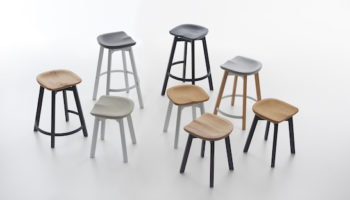Fittorio Leksono’s Smile Stool
Have you ever wondered what happens when a venerated cultural tradition of fine wood craftsmanship is forced to compete against the juggernaut of mass manufacture? In the case of the Indonesian tradition of artisanal woodworking, the scenario is a decided competitive disadvantage, especially when the competitor is China’s furniture manufacturing industry. However the recent Smile Stool by Indonesian designer Fitorio Leksono indicates an auspicious industry uptick. The piece demonstrates how to minimize construction waste while streamlining assembly.
Smile Stool. Designed by Fittorio Leksono.
Reclaimed Teakwood and Homegrown Ingenuity Turn Out the Smile Stool
Up till now, the more than 3500 Indonesian furniture manufacturers have stuck to their artisanal guns and resisted any move toward automation. But Leksono’s stool suggests a propitious middle ground. The piece incorporates a “module” method of construction and assembly that preserves artisanal craft while incorporating some of the efficiencies of mass assembly.
Additionally, the Smile Stool is constructed exclusively of reclaimed teakwood. This is a far cry from burning the excess up as fuel—the typical use of construction waste in the Indonesian furniture industry.

Leksono refers to Smile’s module system of assembly as “semi mass-manufacture.” The Stool is comprised of 31 distinct modules, each of which is handcrafted by local artisans. The whole piece is then put together in rapid assembly fashion by local workers, thus preserving the best tradition of local wood craftsmanship while increasing Indonesia’s competitiveness on a global scale.
About the Designer: Working out of Bali, Indonesia, designer Fitorio Leksono has managed to blend the best of both worlds. That is to say, the young artisan has been able to preserve the timeless Indonesian tradition of wood craftsmanship while updating the packaging of such to the rest of the world. His work with the sustainable “Smile Stool” has been an instructive exercise for the Indonesian furniture industry. The piece effectively demonstrates how to increase efficiency and output while making best use of resources—without sacrificing an iota of aesthetic allure.




Leave a Reply